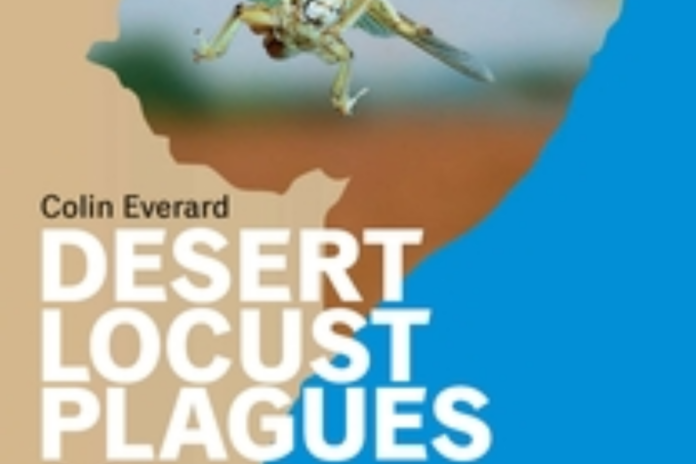Colin Everard, having dedicated ten years to accumulating substantial knowledge on locust swarms in the Horn of Africa, shares insights from his book “Desert Locust Plagues: Controlling the Ancient Scourge.”
In this excerpt, he illuminates the formidable challenges of managing and mitigating the danger of locust swarms, outlining the complexities involved. Additionally, he discusses potential strategies for reducing the future threat posed by these swarms.
Over the past few weeks, East Africa has been grappling with a severe locust infestation, posing a threat to crops and pasturelands in a region already dealing with challenges like droughts and floods. The Food and Agriculture Organization (FAO) reports that Kenya is experiencing its most significant locust outbreak in seven decades. Ethiopia and Somalia are dealing with their largest infestations in 25 years. Controlling these massive locust plagues is a pressing concern.
(At the Somaliland coastline, a specialist in desert locust control is speaking)
Unprecedented Locust Swarm Invasion On Somaliland’s Coastline
A colossal swarm has arrived from the opposite side of the Red Sea. I traversed the area in a jeep, estimating its coverage at around a hundred square miles. The mature adults, identifiable by their yellow hue, took advantage of the soft ground to deposit their egg pods, with each pod containing 50 to 150 eggs, resulting in an immense multiplication factor.
The mature adults have since flown away, boasting a flight speed of twelve miles per hour in calm air, potentially covering up to twenty or thirty miles per hour with a tailwind. To sustain themselves, locusts must consume a minimum of half their body weight in food daily. While exact figures are challenging to ascertain, a typical swarm of this magnitude might weigh approximately thirty-five thousand tons. Just imagine the scale of this invasion!
Read: Degenerate Women
Life Cycle And Destructive Patterns Of Locust Swarms
The swarm has entered a breeding phase, and the eggs are now in the process of hatching. Soon, the small locust nymphs, called ‘hoppers,’ will commence hopping around in search of edible vegetation.
As the hoppers progress, they gradually form bands that grow in size, eventually transforming into vast armies that traverse the terrain, consuming everything in their path. After approximately a month, the hoppers develop wings.
At a certain point, seemingly orchestrated by a leader, the young locusts come together to form a swarm, embarking on a relentless and destructive airborne journey.
Our strategy for locust control revolves around minimizing the size of the subsequent generation. If executed effectively, the chances of a significant locust ‘escape’ diminish. Natural factors such as predatory birds and other environmental elements play a role in the final reduction.
To diminish the hopper population, we employ the method of dispersing poisoned bran in the path of the advancing hoppers. The hoppers consume the bran, leading to their demise due to stomach poisoning.
Origins And Reproductive Cycle Of Locust Swarms In The Horn Of Africa
The typical swarms infiltrating the Horn of Africa often initiate their flight from the Arabian Peninsula. As they journey across the Horn region, the mature locusts take advantage of the softened sandy soil, courtesy of the biannual rains, to breed and lay egg pods in the sand.
The young pink locusts undergo rapid maturation, transforming into a solid yellow color, signifying their readiness for reproduction.

Witnessing a colossal, tightly-packed swarm in flight leaves an indelible mark on anyone fortunate enough to observe it. Gazing skyward, an observer witnesses an endless stream of locusts flying overhead, their wings shimmering in the sunlight.
The ears pick up the low hum of the millions of airborne insects, creating a mesmerizing experience. Most significantly, a profound sense of complete helplessness takes hold.
Contemporary Challenges In Achieving Comprehensive Desert Locust Control
To comprehend the existing obstacles hindering the attainment of thorough desert locust control, it is imperative to address a fundamental issue. A significant overarching challenge lies in the reality that numerous countries grappling with locust infestations are categorized as Third World nations. This circumstance directly influences the capacity of these countries to effectively manage and combat desert locust plagues.
The approach to addressing challenges in Third World countries often diverges significantly from the strategies employed by developed nations facing similar circumstances. Developed countries benefit from robust, seasoned infrastructures, a luxury not consistently available in developing nations.
While developed nations have easy access to financial resources, the financial condition of Third World countries is frequently precarious, particularly in securing vital foreign exchange (hard currency) for acquiring essential equipment or services.
As an illustrative instance, the substantial capital investment required to purchase aerial spraying aircraft would undoubtedly constitute a significant financial burden on a constrained budget.
Similarly, the expenses associated with aircraft maintenance and the funding required for the salaries of the crew members present additional financial challenges.
Funding Challenges For Locust Control Projects
To fight against the desert locust plagues swarms that threaten their crops, every country that faces this problem agrees to invest in the necessary staff and equipment. But this is not easy, as they also have to allocate money for other important issues, such as reducing poverty, enhancing education, and providing health care.
The world community is vital in helping countries deal with the desert locust plagues outbreaks that endanger their food security. If the world community does not provide enough help, the locusts will cause severe damage to the country that suffers from them. This damage will include the loss of crops and pasture, leading to widespread famine and death.
Humanity, in a state of self-conflict, suffers from violence, wars, various forms of terror, civil unrest, and distrust everywhere. Sadly, this makes it impossible to access key regions in the Horn of Africa for the purpose of managing the locust invasions.
As I have mentioned before, the Hemistio (Ximistiyo) Valley in the northeast of Somalia often hosts large groups of desert locusts. The locusts would be perfect for spraying from the air. But who would dare to go there now? The place is full of pirates; they enjoy taking hostages and hurting people.
Challenges In Aerial Spraying Of Desert Locust Swarms On A Global Scale
In the realm of aerial spraying to control desert locust swarms, it is disheartening to observe the complexities inherent in our tumultuous world. For instance, there are significant obstacles if the decision is made to relocate a locust-spraying aircraft from one country to another.
These obstacles include delays in obtaining clearance from the often skeptical recipient country. Additionally, securing insurance coverage for the aircraft becomes either impossible or financially burdensome due to the perceived high-risk nature of the operation.
Meanwhile, ravenous locust swarms, which may cover up to 150 miles per day, are approaching cultivated areas. However, the option of using spraying aircraft is nullified due to the insurance cost and bureaucratic clearance hurdles.
Locust Swarms Advancing Towards Cultivated Regions Hindered
As ravenous locust swarms, capable of covering up to 150 miles per day, approach cultivated areas, the possibility of deploying spraying aircraft is thwarted by exorbitant insurance expenses and bureaucratic challenges.
Also Read: An Accessible America In The Balkans


